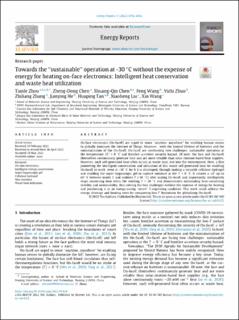| dc.contributor.author | Zhou, Tianle | |
| dc.contributor.author | Chen, Zhengdong | |
| dc.contributor.author | Chen, Shuangqin | |
| dc.contributor.author | Wang, Feng | |
| dc.contributor.author | Zhuo, Yizhi | |
| dc.contributor.author | Zhang, Zhiliang | |
| dc.contributor.author | He, Jianying | |
| dc.contributor.author | Tan, Huaping | |
| dc.contributor.author | Liu, Xiaoheng | |
| dc.contributor.author | Wang, Xin | |
| dc.date.accessioned | 2022-12-02T08:00:49Z | |
| dc.date.available | 2022-12-02T08:00:49Z | |
| dc.date.created | 2022-05-13T13:10:19Z | |
| dc.date.issued | 2022 | |
| dc.identifier.citation | Energy Reports. 2022, 8 6753-6763. | en_US |
| dc.identifier.issn | 2352-4847 | |
| dc.identifier.uri | https://hdl.handle.net/11250/3035526 | |
| dc.description.abstract | On-face electronics (On-faceE) are urged to sense “anytime, anywhere” for enabling human senses to globally dominate the Internet of Things. However, with the limited lifetime of batteries and the miniaturization of the On-faceE, On-faceE are confronting two challenges: sustainable operation at the temperature (T) < 0 °C and frost/ice accretion security hazard. Of note, the face and On-faceE themselves continuously generate heat and are more reliable than solar-/motion-based heat supplies. However, such self-generated heat often occurs as waste heat, lost into the environment. Here, a film pioneering the intelligent conservation and utilization of this waste self-generated heat for enabling On-faceE to work even at -30 °C for 8 h is developed, through making a versatile cellulose hydrogel and enabling the super-hygroscopic gel to capture moisture at the T < 0 °C. It creates a ΔT up to 60 °C between inside T and ambient T (-30 °C) after sealing On-faceE and, importantly, intelligently stops conserving heat when the working Revised manuscript without track changes 2 T > 30 °C and demonstrates outstanding heat-conserving stability and sustainability, thus solving the two challenges without the expense of energy for heating and positioning it as an energy-saving “smart” T-regulating candidate. This work could address the energy shortage and heating costs for conquering low-T limitations for globalizing On-faceE. | en_US |
| dc.description.abstract | Towards the “sustainable” operation at -30 °C without the expense of energy for heating on-face electronics: intelligent heat conservation and waste heat utilization | en_US |
| dc.language.iso | eng | en_US |
| dc.rights | Attribution-NonCommercial-NoDerivatives 4.0 Internasjonal | * |
| dc.rights.uri | http://creativecommons.org/licenses/by-nc-nd/4.0/deed.no | * |
| dc.title | Towards the “sustainable” operation at -30 °C without the expense of energy for heating on-face electronics: intelligent heat conservation and waste heat utilization | en_US |
| dc.title.alternative | Towards the “sustainable” operation at -30 °C without the expense of energy for heating on-face electronics: intelligent heat conservation and waste heat utilization | en_US |
| dc.type | Journal article | en_US |
| dc.type | Peer reviewed | en_US |
| dc.description.version | publishedVersion | en_US |
| dc.source.pagenumber | 6753-6763 | en_US |
| dc.source.volume | 8 | en_US |
| dc.source.journal | Energy Reports | en_US |
| dc.identifier.doi | 10.1016/j.egyr.2022.05.024 | |
| dc.identifier.cristin | 2024361 | |
| dc.relation.project | Norges forskningsråd: 245963 | en_US |
| cristin.ispublished | true | |
| cristin.fulltext | postprint | |
| cristin.fulltext | original | |
| cristin.qualitycode | 1 | |

